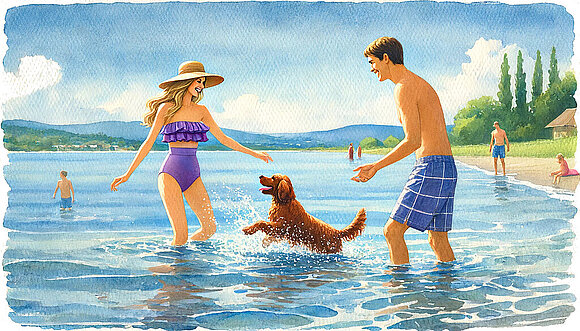Swimming rules for dogs: swim safely & have fun!

Summer is the perfect time to splash around in the water and go swimming with your dog. Whether in the lake, by the sea or in the pool at home - many dogs love the cool water. But just like us humans, there are some important bathing rules for dogs that should be observed to ensure the safety and health of your four-legged friend. In this article, you will learn everything you need to know so that your dog can enjoy the water to the full - from the right preparation to safety tips and post-bath care.
Preparation: What you should consider before swimming
The right equipment
Before going into the water, you should make sure that you and your dog are well equipped:
- Life jackets: a life jacket is a good idea, especially for dogs that are not experienced swimmers or that you are unsure if they can swim long distances.
- Fresh drinking water: Even if your dog is in the water, you should always provide it with fresh drinking water to avoid dehydration.
- Leash and harness: In unfamiliar or high-traffic areas, a special water leash can be useful to keep your dog safe.
Safety tips for swimming and splashing around
Get to know the water
Before you let your dog into the water, you should check the water for possible dangers:
- Depth and current: make sure the water is safe for your dog and that there are no strong currents.
- Substrate: Check the substrate for sharp stones, shells or garbage that could injure your dog.
- Temperature: Very cold water can be dangerous for dogs. Let your dog get used to the water temperature slowly.
Behavior in the water
There are also rules that you and your dog should follow in the water:
- Stay on sight: Never leave your dog unattended in the water and always maintain visual contact.
- Play calmly: Avoid hectic games or throwing sticks in the water, as your dog could choke or injure itself.
- Take breaks: Make sure your dog takes regular breaks and doesn't stay in the water too long to avoid overexertion.
Recognize dangers
Always be alert and recognize potential dangers early on:
- Swimming position: if your dog has difficulty staying afloat, bring him to the shore immediately.
- Do not enter the water on a full stomach: Wait at least an hour after a meal before letting your dog into the water. Swimming with a full stomach can lead to stomach problems and even vomiting.
- Fatigue: Signs of fatigue such as slow swimming or restlessness are an indication that your dog needs a break.
- Ingested water: Make sure your dog doesn't swallow too much water, as this can lead to stomach problems.
- Prevent drinking salt water: Salt water can lead to diarrhea, vomiting and dehydration. Make sure your dog has access to fresh drinking water so they don't drink from the sea.
- Watch out for blue-green algae: Blue-green algae can be toxic to dogs. Avoid bodies of water with visible algae growth or unusual odors.
- Protect your dog from sunburn: Dogs with light-colored or short coats are particularly susceptible to sunburn. Use special sunscreen for dogs and make sure they get plenty of shade.
After the bath: care and precautions
Drying and cleaning
Proper care is important after swimming:
- Grooming: dry your dog thoroughly, especially around the ears, to prevent infection. Brush the coat to avoid matting.
- Paw care: Clean sand, dirt and salt from the paws to prevent irritation.
- Clean ears: Gently dry the ears with a soft cloth to remove moisture and dirt.
Conclusion
Bathing and swimming are great activities that can bring a lot of joy to your dog if you follow a few simple rules. With the right preparation, good observation during bathing and careful care afterwards, nothing stands in the way of safe splashing around. Enjoy the summer and time in the water with your faithful four-legged friend!
More articles for you
Contact form problem fixed
Unfortunately, our contact form has not worked as desired in recent weeks. 😔 Due to an error in the spam detection, normal messages were also incorrectly filtered out.Read moreDangerous encounter: What you should do if your dog is bitten by a snake
It's every dog owner's nightmare: you're out in nature with your four-legged friend, he's sniffing the ground curiously, and suddenly you hear a hissing sound. Before you know it, your dog flinches and you recognize the signs of a snake bite. But don't panic! In this article, you will learn how to…Read moreWhat you should know about cherries for dogs
You may have heard that cherries are good for your health. They contain lots of vitamins, antioxidants and fiber, which can strengthen the immune system and aid digestion. But are cherries also suitable for dogs? And if so, how much and in what form should you offer them to your four-legged friend?…Read more


